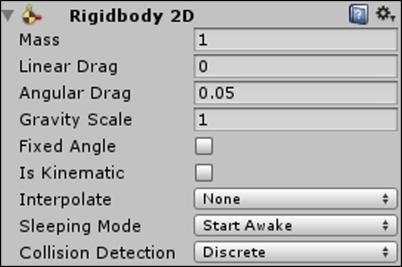The Rigidbody 2D component sets an object/body to be affected by physics. To create a Rigidbody, we can follow the same steps as our previous games by going to Add Component | Physics 2D | Rigidbody 2D.
The following screenshot shows the result:

We will go through all the Rigidbody settings. These are described as follows:
Mass: This refers to the mass of the object/body
Linear Drag: This drag affects the movement in position
Angular Drag: This drag affects the rotation of movement
Gravity Scale: This is the amount of gravity that affects the object/body locally
Fixed Angle: If this is enabled, then the Rigidbody is able to rotate when it's affected by a force
Is Kinematic: This sets whether or not the Rigidbody is kinematic for instances where we want to manually animate the rigid body's position
Interpolate: The interpolation settings between the physics engine's updates (when the physics calculations are updated)



